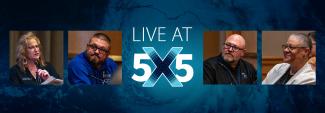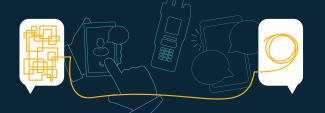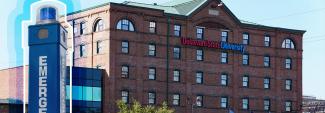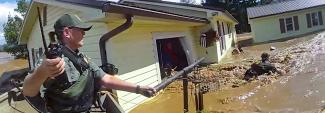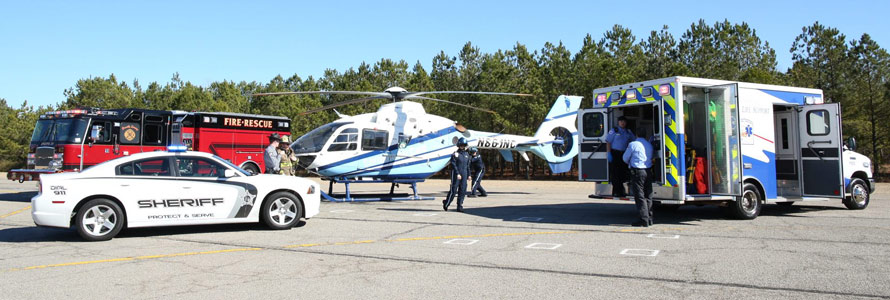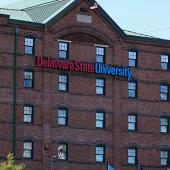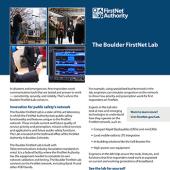Summary
In this episode of Public Safety First, FirstNet’s Senior EMS Advisor Brent Williams chats with Plain Township (OH) Assistant Fire Chief Jack Rupp and Dr. Paul Zeeb, EMS Medical Director for Ohio’s Metropolitan Emergency Consortium Communications (MECC), at the 2018 EMS World Expo. Together, they reflect on how FirstNet will enable emerging technology in the world of EMS.
Guest
Brent Williams
FirstNet Authority EMS Senior Advisor
Assistant Fire Chief Jack Rupp
Plain Township, Ohio Fire Department
Dr. Paul Zeeb
Medical Director for the Metropolitan Emergency Communications Consortium
Transcript
Preview
Narrator: You're listening to Public Safety First – a podcast to help you learn about the First Responder Network Authority and how you can be part of the future of public safety technology. And now, your host.
Brent Williams: Hi everybody, this is Brent Williams, the senior EMS advisor at FirstNet – the FirstNet Authority, and we’re at EMS World today, the 2018 version that’s being held in Nashville, and I have two providers here that are very involved in the EMS world and we wanted to talk to them a little bit about FirstNet and how it impacts them, their impressions of what we’re learning here, and what we’re seeing here at EMS World. Jack Rupp is with me. Jack’s an Assistant Fire Chief in the middle of Ohio, I guess is probably the best way to put it, and glad to have you here with us Jack –
Jack Rupp: In the capital area, yeah.
Narrator: You're listening to Public Safety First – a podcast to help you learn about the First Responder Network Authority and how you can be part of the future of public safety technology. And now, your host.
Brent Williams: Hi everybody, this is Brent Williams, the senior EMS advisor at FirstNet – the FirstNet Authority, and we’re at EMS World today, the 2018 version that’s being held in Nashville, and I have two providers here that are very involved in the EMS world and we wanted to talk to them a little bit about FirstNet and how it impacts them, their impressions of what we’re learning here, and what we’re seeing here at EMS World. Jack Rupp is with me. Jack’s an Assistant Fire Chief in the middle of Ohio, I guess is probably the best way to put it, and glad to have you here with us Jack –
Jack Rupp: In the capital area, yeah.
Brent Williams: Yup, and he's also brought along his medical director. There’s a coalition there of about 17 different EMS agencies that all work together providing EMS service as part of the EMS system and that’s Dr. Paul Zeeb. Doctor, welcome, welcome to join us.
Dr. Paul Zeeb: Thank you, it’s good to be here.
Brent Williams: Glad to have you all here. So what, tell me, what your impressions are of EMS World? What do you, what are you seeing that’s new? What impresses you about the conference this year?
Jack Rupp: Well, I always enjoy coming to the conference in that and one is I get to come with our people and get to have some more personal time with our firefighter paramedics here that I don’t normally get in the station and that, it’s been, it’s been a good conference. This is my second year coming to the EMS Expo, so I’ve enjoyed it each time. There’s good information in that, went to an ultrasound session this morning and that, and so, went to a, the heart dissection section, so there’s always good programs.
Brent Williams: Great. Doctor, what, what are your impressions?
Dr. Paul Zeeb: Oh, I think it’s been a great conference. I always enjoy listening to other people, hearing what other people are doing, in either other parts of the country or even other parts of the world. It’s a very good conference.
Brent Williams: Let me ask you this: we’re primarily EMS people, and the physicians kinda have their own world that they talk together, do other medical directors get together and really talk about EMS issues?
Dr. Paul Zeeb: Um, I’ve met with some medical directors here, we have other medical director conferences such as the one put on by the National Association of EMS Physicians, which is every January. Uh, Eagles is another conference that is physicians-oriented in terms of EMS, and state-of-the- art, and forward thinking.
Brent Williams: Tell me a little bit more about your background. I did a quick introduction for both of you. What’s your background, and specially, particularly as it pertains to EMS?
Jack Rupp: Well, my background has been in the fire service for over four years. And so part of that’s been EMS, and been a paramedic for over 35 years, and so, and before coming into the position I’m in now, the department I was with before, I was EMS coordinator there, and helped establish our ALS program there, so I have a pretty extensive background there. And I was fortunate on my days off while I was on companies, I flew as a flight paramedic on one of the programs in, in central Ohio.
Dr. Paul Zeeb: I’ve been practicing emergency medicine for 35 years. I’ve been involved with EMS for just about as long. Actually, I met Chief Rupp as I was still a resident teaching ACLS at his department at the time, so I’ve been involved with EMS and interfacing with EMS providers my whole, entire professional career.
Brent Williams: So, any particular topics that have come up here that have been important to you?
Jack Rupp: Any particular topics? Well yeah, I think that you know, we’ve talked about the ultrasound stuff and we’ve talked about some of the new things, so I mean, I’ve been particularly interested in that
– been particularly interested in [the] research and data side, they’re talking about, and that, because, you know data is going to guide where we’re at, what we’re going to be doing in the future, and so to have accurate data from the field is really, really important.
Brent Williams: Let’s think about technology. You know, you mentioned the data communications, that type of thing. Have there been recent incidents that you can think of in your agencies or in other agencies around you, where something other than voice communications would have been helpful to you?
Jack Rupp: Well, I think that – that some of the things particularly in some of the areas that we’re looking at is the rescue task force, and looking at buildings, looking into our schools and being able to have data on a tablet that helps them negotiate through schools. Our school is on a campus setting so we have about 4,500 - 5,000 people in a campus setting, so for a school district being that compact in an area, it provides some significant challenge in being able to move through the school buildings. So, to be able to have data, and be able to have the pre-plans, and be able to have Connect cameras, that are on the campus, I think are going to be a very important piece for us.
Brent Williams: And doctor, on the medical side of things, we mentioned earlier, just touched briefly on ultrasound, and that seems to be moving now from the ER out to ambulances. We’re seeing more and more discussion of field ultrasound. How do you see broadband communication working on the medical side with actual patient medical care?
Dr. Paul Zeeb: Well I think for medical care, I think in the past, EMS and healthcare in general have been very silo-oriented. I think we need to move from that to more of a continuum of care. We see that now when we talk about those time-critical events like STEMI, sepsis, or some trauma, or even stroke, Where you know, what EMS providers do in the field is important and must be communicated to the receiving facilities so they can ramp up appropriately. You asked about ultrasound, I think ultrasound is slowly coming. I think there are going to be significant scope of practice issues. A component, or way to deal with that, may be where the medics serve as an ultrasound tech, they perform an ultrasound procedure, so rather than interpreting it, they are able to transmit that to a receiving facility, where someone else can interpret it. I think that may be a good first step, versus trying to get them fully credentialed where
they can provide ultrasound services in the field and get past all the different scope issues. It’s similar to what we did with 12-lead ECGs, 15-20 years ago, when the first steps were the providers in the field
collected the information and sent it to the hospitals, and we’ve migrated to where they’re now able to interpret those electrocardiograms. So, I think the ability to transmit that data is very important.
Brent Williams: I’ve heard some paramedics –and that’s my background, of course, I’m an old paramedic from back in the 70s. I’ve heard some paramedics say that well, having like video in the back of the ambulance would make it feel like there was someone looking over their shoulder and intruding
in what they do. I’ve always thought it’s more, it extends your capability. It provides more backup, more resources for you. And is that how you would see it from the hospital side, from the physician’s side?
That it gives you the opportunity on those critical patients to be more involved?
Dr. Paul Zeeb: Oh I think it does, because now we’re used to looking at the you know, the medic’s cellphone pictures from the scene so we have an idea of what the magnitude of injury was, or what the circumstances of the patient injury. I think we all are a little paranoid about having video available, and where everything we do is being videoed, but you know, our greatest risk is not what we do to ourselves, but what the public does with their cell phones. So, I think that you know, if we’re worried about our behavior, then we should be worried about our behavior now, not in the future when we may be videod real-time. But I think there are tremendous capabilities that we could use that for.
Brent Williams: Jack, at the administrative level at your department, when you made the decision to join FirstNet, to use FirstNet connectivity, walk us through that process. How did that go for you?
Jack Rupp: Well, we’ve got one of our firefighters that is pretty talented and can write software programs, manages a lot of our networks, and that, and so he stays up on top of things. Being out in April at NIST, was, we’re well aware of the data piece being available in our area and Jason researched it, looked into it, and came to us and said ‘hey, you know, they can provide us a savings and I think that it’ll work.’ Well, we wanted to be certain cause we you know, we had good coverage with our provider at that time, and so we said, let’s try it. If they’ll give us a data card that we can put into one of the medics that we know we’re getting high data use on, I’d like to do that. And so they provide us a card that we put in to our cradle points and we ran it for about two months, and during that time period, he looked at the data service and found no interruptions and so based upon the savings and the persistence of the cards, and our network communications, we made the decision to change our vehicles over to FirstNet, and it’s been a positive decision cause it’s saved us money and it’s been reliable.
Brent Williams: That’s a great comment, thank you. So, where do you see FirstNet impacting public safety in general, but in particular, where do you see it impacting EMS? For the chief, and then we’ll ask the doctor.
Jack Rupp: Well I think in terms of the data collection and reporting, I mean, that’s where we’re using it right now is that, you know, we’re using and switched to FirstNet earlier this year as our data transport network, and so based upon what we’re using in our vehicles is, our mobile data computers are hooked to it, our reporting computers are hooked to it, and so you know, it’s the backbone right now for the exchange of that information. And then it allows us to pull information up from our record management system to the field, so I think that those are things that streamline our event and give us more information in the fields.
Dr. Paul Zeeb: I think we have to be able to communicate bi-directionally and data is key to part of that. The days of just operating in a vacuum I think need to go away. We need to have some idea of what a patient’s past history has been, what interventions have been performed, which facilities are providing care. Often patients are not aware of what their drugs are, medications are, and it may make a difference for what we do in the field. So, the ability to have that bi-directional communication I think is key.
Brent Williams: Great. Thanks gentlemen, appreciate talking to you today. So, what do you see in the future for FirstNet? So often we think about it as a smartphone, something an app on our smartphone or something, do you see other devices coming into play? And maybe think into the future a little bit, what would benefit you and your work?
Jack Rupp: Yeah, well, on the first standpoint, there’s great applications for it in the future. One of the things that our organization, that our consortium is that we got involved with a company called TRX and it’s TRX Systems, and their focus is location-based services and structures that are absent of GPS information so that you can track a firefighter through a building. And, and because of that, I’ve been involved with NIST in the Public Safety Communication Research Group, and we were at a workshop in April and part of that workshop was developing a challenge to where we could facilitate in the future, hopefully, getting various applications and providers into the marketing network to be able to provide devices where you can track firefighters through a building. And it’s easy to map a building like we’re sitting in now, because they can put tags through that building that helps you find where you’re at, your phone or the devices recognize that. But the issue for us is, that you know that 60-60 percent of the maydays and disoriented firefighters come in residential communities, in residence, and it brought interest to us because of the communities that we serve. We’re seeing larger and larger homes. The community that I serve in, our average residence is 5,000 square feet. And so you know for us, if we have a firefighter disoriented, you know, that’s serious, and we need to be able to find out where they are and we need to also figure out a way that they can regain their orientation, so those are all things that NIST and the public safety research are trying to do is establish that. And part of the challenge that we participated in April at their campus in Boulder, was to develop a challenge to have providers come in sometime in 2020 to tests their devices and then based upon the testing of those devices, they would actually get awards to help them facilitate the development and the actual release of those products out there. And with TRX, the FirstNet plays an important part because part of their application is the use of Android phones at this point to do some of the well, to do the data transport to the cloud as well as it has an app on it that supports you know, the overall system.
Brent Williams: You have the relationship with TRX coming out of the PSCR program, the Challenge Grant program there, tell us a little more about how you’re going to be using that, what it’s going to do, what you hope to learn from it?
Jack Rupp: Well, when we first started out with TRX, and we’ve been involved with them in the testing capacity for a number of years now. We were looking at how do we communicate with the devices out to a computer so there’s a visual representation of a firefighter moving through a residence. And, and we insisted the communication link needed to be something other than a public network just because of problems and particularly, with residents with cell networks at the time. And we attempted at first to use the data side of the land-mobile radio system, as a Motorola’s system, and it worked, but it didn’t work well because it couldn’t deliver enough packets because the location-based services requires so much data that we could maybe put four devices on there, but beyond four devices, you know, it just, it just didn’t work. And so you know, at an incident, we’re going to look at, at least in our community and in central Ohio, we put, you know, on an average, on a report of a fire, 18-20 firefighters on a scene. So if we want to track all of those, naturally it’s not going to work that way. So, we’ve moved to an Android device and the Android devices that we’re testing are on the FirstNet. And just because of the magnitude of the data, and they seem to be working real well. And the other piece that it’s given us is before, the only person that had an opportunity to be able to see the location of the firefighter in the case of a down firefighter and where they were moving and trying to determine a rescue path or you know, when they’re doing searches, was somebody with a computer in a command post or at a dispatch center. Now with the Android devices, other people, users can pull up an Android app and actually look at where people were moving about the incident and the indoor services. So that data piece and the amount of data that it’s got to be able to take and move to be able to accomplish that, requires a pretty healthy network.
Brent Williams: Great, okay. Doctor, what would you like to see in terms of technology, devices, capabilities, that FirstNet would enable?
Dr. Paul Zeeb: I think a couple of easy examples are, you know, one would be the ability of our community paramedics or even our street providers to access patient information via health information data exchange. I think that’s huge. I think another real world opportunity is telemedicine, with the ability to have a nurse or physician assist the EMS provider in terms of treatment decisions and decisions regarding transport. So I think one of the key areas of focus in the next five to ten years both for EMS providers and for healthcare payers is going to be taking patients to alternative treatment locations and to do that I think we’re going to need to have telehealth available and I think that’s going to require assured broadband communication capabilities, so that you can make those decisions and evaluate patients real-time.
Brent Williams: Yeah, that higher-level decision-making, that’s, that’s really the key.
Dr. Paul Zeeb: Correct. I think there’s going to be a big push, there is already a big push, to take patients to alternative treatment locations. I think the easiest first step would be patients with psychiatric illness. If we can provide medical clearance in the field regardless of time and day and move the patient to an appropriate psychiatric facility rather than burden emergency departments with psychiatric patients. I think that would be a big first step.
Brent Williams: Yeah, medicine is certainly changing, all of medicine. And this – what you’ve touched on here are just some of the issues that are changing.
Dr. Paul Zeeb: Yeah, and I think a lot of that is going to be driven by the payers.
Brent Williams: Yeah, exactly.
Dr. Paul Zeeb: And that would also involve – give us an opportunity to involve them in the thought process, but also in the means of covering the costs for providing these services.
Brent Williams: And that’s a whole other issue, right? When we get into the payer system, and could be for good or for real I guess, but yeah, you’re exactly right.
Dr. Paul Zeeb: And for that to work, you have to have broadband.
Brent Williams: Yeah, exactly, exactly. Well I have to ask, tell me what drives you to do this? You know, people who are involved in working in public safety, working in medicine, it’s a real calling. And so, each of you, just share a little bit with us about why do you do this? What is it that drives you to get up in the morning and do what you do, for both of you?
Jack Rupp: Well I’ll tell you, I actually retired once. And I guess I got bored and missed it so much that I went back. And so, and really when I went back, I didn’t figure that I’d go back for a really long period of time, but just seeing you know, the growth of our department and the evolution of our department, and the kind of staff that we have in the community that we’re in, it just re-energizes me and looking at the possibilities. I’ve got three sons that are in the fire service, and so to you know, to improve things that might vastly affect them, because they’re not in the same area, you know, they’re in different parts, but to be able to do things with TRX and be able to do things with NIST and the public safety research are things that just keep me energized. So I’m probably not going to walk away anytime soon.
Dr. Paul Zeeb: Well for me, it’s about providing service to the community and our patients in the community. I also like the opportunities to be innovative and I actually, I enjoy the can-do attitude of EMS, which you know, when you’re used to working in a hospital, which in itself is an administrative behemoth, you’re able to get things done I think more quickly and with a more positive attitude in working with pre-hospital providers. You know, it doesn’t matter what the circumstance is, you still have to deal with the situation at hand, you can’t put it off. So, I kind of enjoy that can-do attitude.
Brent Williams: Great to hear. Well gentlemen, thanks for talking with us today. Jack Rupp, an Assistant Fire Chief, and Dr. Paul Zeeb, Medical Director. They’re in central Ohio, and any closing thoughts?
Jack Rupp: Any closing thoughts? Well I think that everybody should take an opportunity to take a look at NIST and the work that they’re doing with the Public Safety Communication Research. And I know they’re very actively involved in helping with FirstNet and the facilitation of getting FirstNet out there, and then just all the capabilities that will come down the road through the cooperation of both government agencies.
Dr. Paul Zeeb: I guess for me, it’s, there’s going to be bumps in the road, but keep moving forward because times are changing and I think our goal should be to stay ahead of the curve rather than try to catch up.
Brent Williams: Thanks gentlemen, appreciate talking to you both.
Dr. Paul Zeeb: Thanks Brian.
Jack Rupp: Thank you.
Narrator: Thanks for listening today. We're excited to have you join our podcast community. Make sure to subscribe on iTunes, SoundCloud, and YouTube. You can learn more about the First Responder Network Authority at FirstNet.gov and learn about FirstNet products and services at FirsNet.com



